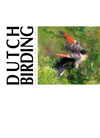Dutch Birding volume 33 (2011) no 5

Steppe Buzzard in the Netherlands: revision, status and identification
The status of Steppe Buzzard Buteo buteo vulpinus in the Netherlands has been controversial for a long time. The subspecies was placed on the Dutch list based on 30 old specimens and a number of undocumented field observations. A revision was long overdue (the taxon was not included in the large-scale revision of the Dutch list in the 1980s and 1990s) and has finally been undertaken in recent years by Nils van Duivendijk, on request of the Dutch rarities committee (CDNA). The results of this review are presented in this paper. Apart from already widely published biometrical criteria, a number of morphological differences have been identified (based on studies of skins, photographs and publications, on field observations by NvD and on correspondence with raptor experts) and these are presented here.
Only three specimens collected in the Netherlands fell within the measurements fitting vulpinus. After considering other (morphological) characters, only two specimens were considered acceptable by the CDNA and these two records remain the only ones currently on the Dutch list (16 April 1902, Twickel, Hof van Twente, Overijssel, adult male, collected, plate 365-366; and 11 April 1908, Ravensbosch, Houthem, Valkenburg aan de Geul, Limburg, adult male, collected, plate 367-368). The measurements of the third specimen (plate 369-370) fell in the overlap zone with nominate buteo and this bird showed intermediate morphological characters and, therefore, it was not accepted.
The most important characters discussed in this paper refer to three categories: biometrics, morphology and moult. Biometric differences refer to: 1 general shape (vulpinus is smaller and looks slightly narrower winged and longer tailed than nominate buteo); 2 wing length; 3 tail length; and 4 width of adult-type central tail-feathers (all measurements smaller, on average, than in nominate buteo, with some overlap except for width of tail-feathers).
Morphological differences refer to: 1 general plumage (vulpinus is less variable and occurs in four main morphs: 'grey-brown', 'rufous', 'dark rufous' and 'black'; vulpinus often shows rufous in tail, scapular fringes and undertail-coverts; grey-brown morph often very similar to nominate buteo); 2 head pattern (rather uniform head in all plumages compared with nominate buteo, with dark eye-stripe); 3 tail pattern (often rufous-orange ground-colour of tail; combination of rufous and grey tones in tail indicative of vulpinus; often narrow subterminal tail-band, rest of tail with (very) narrow dark barring with often relatively large spacing, often only 5-6 bars, but more dense barring occurs; 4 pattern on underparts (often lacks broad pale 'U' on breast but narrow pale 'U' often present; in most adults, barring on underparts, at least on belly); in first-year birds (from first autumn to next spring), dark longitudinal stripes on underparts like nominate buteo but more evenly spread and more drop-shaped to heart-shaped; usually less distinct pale 'U' on breast than in nominate buteo; 5 thigh-feathers and rear flank (often uniformly dark and never very pale in vulpinus); 6 upperwing (grey cast is indicative for vulpinus); 7 underwing (contrasting underwing pattern with white central band); 8 density of barring on underside of p6-7 (absence of barring on tip indicative for vulpinus); 9 width of barring on underside of secondaries (narrow in vulpinus); 10 pattern on underwing-coverts (paler median coverts on underwing creating pale band); and 11 ground colour on underside of flight-feathers (consistently white in vulpinus, variable and often greyish in nominate buteo). The diagnostic value of these morphological characters is variable.
Moult differences refer to a more steplike pace of moulting in vulpinus. Adult moult is suspended during migration and completed in the winter range (December-January); in nominate buteo, adult moult is completed in November (sometimes apart from some primaries). Juvenile moult in vulpinus does not start in autumn but at the beginning of the second calendar-year (body moult first); in nominate buteo, juvenile body moult starts in late autumn by which time some barring could appear on underparts. In the autumn of the second calendar-year, primary moult is suspended in vulpinus, with 3-5 primaries still juvenile; in nominate buteo of this age, normally 2-4 primaries are still juvenile.
Separating vulpinus from nominate buteo if no measurements are available is not safely possible in most cases and requires extremely good photographs or video images. Individuals with field marks of nominate buteo and vulpinus occur at least in north-eastern Scandinavia and eastern Europe. Moreover, within the range of nominate buteo individuals occur with a rufous tail and sometimes rufous other parts. The 'grey-brown' morph, which is most similar to nominate buteo, occurs in the western part of the range, where intergrades with nominate buteo probably occur over a wide area. As a consequence, only birds showing the following combination of plumage characters may be acceptable for national or regional rarities committees on plumage only: 1 uniformly orange or rufous tail or orange or rufous tail with only thin dark subterminal band in adults; and 2 uniformly dark rufous to (warm) blackish-brown underparts, regardless of age.
When identifying vulpinus, the possibility of Long-legged Buzzard B rufinus (especially Atlas Long-legged Buzzard B r cirtensis, which is much smaller and more compact than nominate rufinus) and of an (escaped) Red-tailed Hawk B jamaicensis should also be considered.
Nils van Duivendijk, Veluwemeer 82, 3446 JC Woerden, Nederland
(nils.van.duivendijk @casema.nl)
@casema.nl)
back






